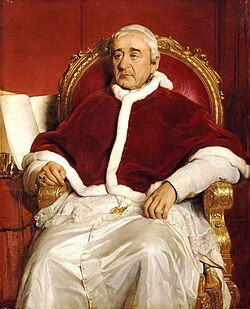Description
When the conclave convened on 14 December, some 45 of the 54 living cardinals participated; eight of whom were not Italian. [2] Bartolomeo Pacca presided as dean of the College of Cardinals.
Initially the chief candidates included Emmanuele De Gregorio and Bartolomeo Pacca, who had been papabili in the 1829 conclave, plus Giacomo Giustiniani, who was a long-serving papal diplomat but who was vetoed by King Ferdinand VII. Giustiniani had served as nuncio at Madrid and provoked the hostility of the prime minister in ecclesiastical matters, [3] and Queen Christina regarding the succession. [2]
From the first day of the scrutiny, which was the 15th, up to the 27th, the votes were fairly evenly divided between De Gregorio and Pacca. However, it became clear eventually that neither of the unvetoed papabili could gain the support of two-thirds of the cardinals, and with Prince Klemens Wenzel von Metternich wanting a very strong pope to hold firm against the flood of revolution haunting Europe at the time of the conclave, Giuseppe Albani, who led the Austrian faction and supported Pacca, [1] intervened. He proposed Vincenzo Macchi, former nuncio in Paris, as his candidate, but few of the other cardinals saw Macchi as suitable for the papacy. Cardinal Joachim-Jean-Xavier d'Isoard was instructed by King Louis-Philippe of France to place a veto against the election of Macchi if necessary. [4] Cardinal Tommaso Bernetti, who vied with Albani for the position of secretary of state, threw his support to De Gregorio.
Cappellari appeared as an alternative to both De Gregorio and Macchi only when the conclave was well-advanced, but even though Albani worked against him, Cappellari eventually took the lead and won the election, taking the papal name Gregory XVI.
No conclave since has lasted as long as a week, but at the time no conclave since 1667 had lasted fewer than three weeks. The conclave took eighty-three ballots to deliver a two-thirds majority to a candidate, whereas no conclave since has taken more than fourteen.
Cappellari, then a Camaldolese priest and prefect of the Congregation for the Propagation of the Faith, was also the last pope not a bishop when elected. [5]
Cardinal electors by region| Region | Number |
|---|
| Italy | 36 |
| Rest of Europe | 9 |
| North America | 0 |
| South America | 0 |
| Asia | 0 |
| Oceania | 0 |
| Africa | 0 |
| Total | 45 |
|---|
This page is based on this
Wikipedia article Text is available under the
CC BY-SA 4.0 license; additional terms may apply.
Images, videos and audio are available under their respective licenses.
